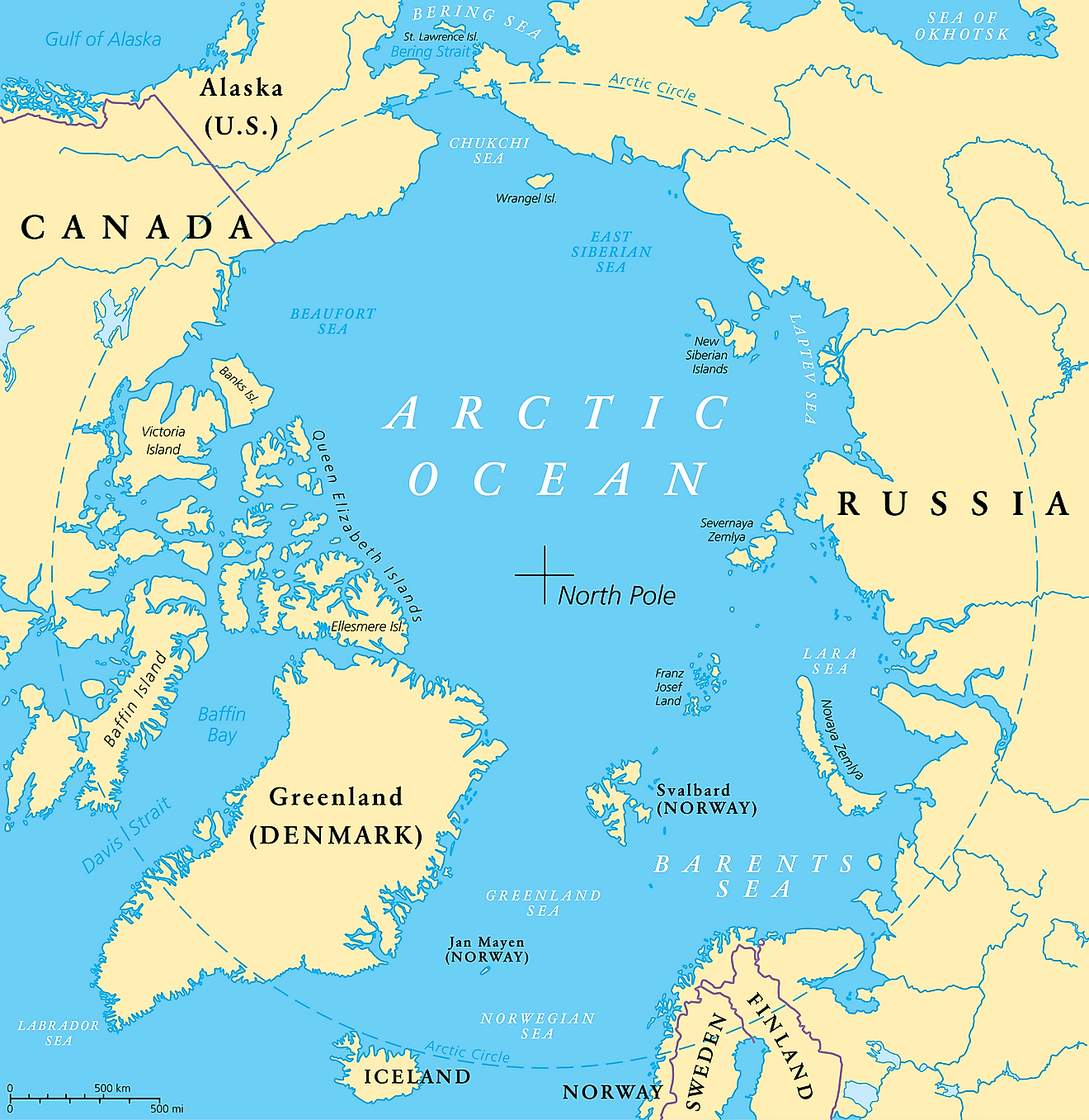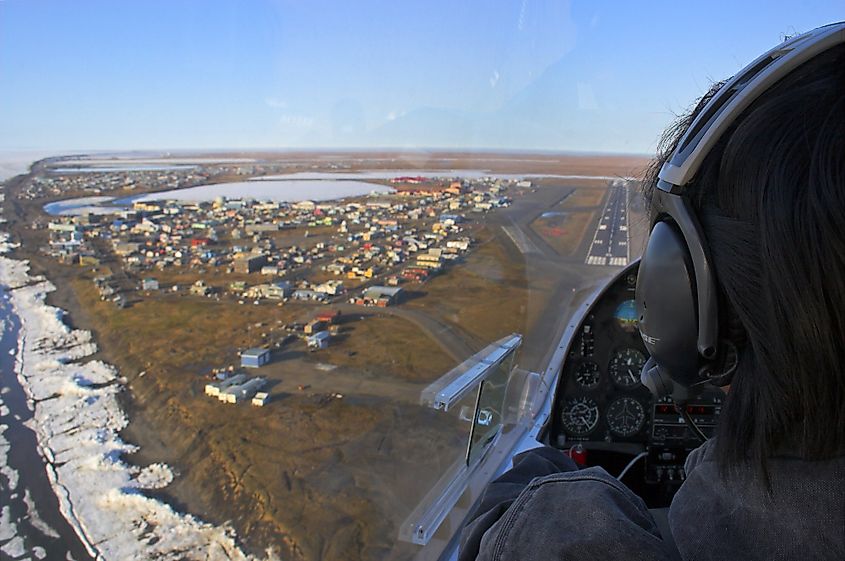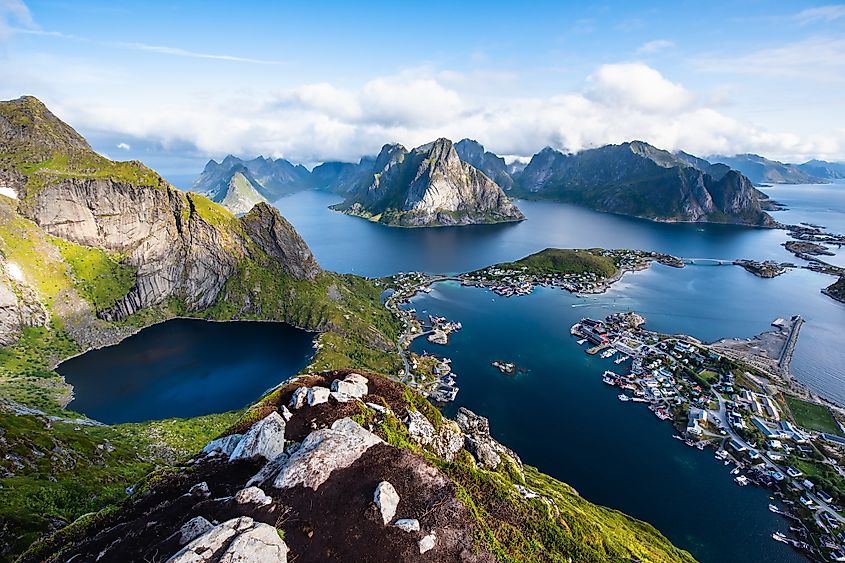Countries With Arctic Ocean Coastlines

The Arctic Ocean covers an area of 5,440,000 square miles within the Arctic north polar region, making it the smallest of the world's five oceans. However, although recognized as an ocean by the International Hydrographic Organization, some oceanographers consider it to be a sea rather than an ocean. The Arctic Ocean reaches a depth of 18,050 feet at its deepest point, but has a much shallower average depth of 3,240 feet. The Arctic Ocean is unique in it almost surrounded by North America and Eurasia. Countries with coastlines in the Arctic Ocean are:
United States

The United States (US) has coastline on the Arctic Ocean in the state of Alaska. According to the US government, the country's coastline on the Arctic Ocean is approximately 1060 miles long. This coastline with the Arctic is extremely important to the US since it is the site of the country's northernmost point, which is Point Barrow, Alaska. In addition to being the most northerly point in the US, Point Barrow is also significant since it marks the boundary between the Beaufort Sea and the Chukchi Sea, which oceanographers consider as the marginal seas of the Arctic Ocean. Some key places on the American coast of the Arctic Ocean include Prudhoe Bay and the city of Utqiaġvik. Prudhoe Bay is important because it is considered the unofficial end of the northern section of the Pan-American Highway, and also attracts tourists, most of whom are looking to observe the tundra.
Canada
Canada has the most extensive coastline in the world, part of which is situated along the Arctic Ocean. One of the most important towns on the Canadian edge of the Arctic Ocean is Churchill, Manitoba. The town is sometimes referred to as the "Polar Bear Capital of the World" due to the large number of polar bears that travel to the area during autumn. Due to its unique location, Churchill attracts a significant number of eco-tourists every year, which can exceed 10,000 according to some estimates. The polar bears are usually the main tourist attraction. Another important town on Canada's coastline with the Atlantic is Nanisivik, Nunavut, which was built for workers of the Nanisivik Mine. After the zinc-lead mine was closed in 2002, residents abandoned it and the Canadian government transformed it into a naval station. The naval station was established so that the government could enforce its control of the region. Ships stationed at the naval base are expected to have icebreaking capabilities, and the Canadian government is expected to deploy Victoria-class submarines to improve its control of the region.
Russia

Russia's coastline on the Arctic Ocean is one of the country's most important coastlines since it covers such an extensive distance. Some of the most important towns along Russia's Arctic coastline include Murmansk, Arkhangelsk, and Labytnangi. Murmansk is a large city along the Arctic Ocean, with an estimated population of 299,148 people in 2014, and was the last city that was established during the era of the Russian Empire. It serves as an important port because it remains relatively ice-free throughout the year due to the warm North Atlantic Current. Murmansk is also known for being the only area in the world with a fleet of icebreakers powered by nuclear energy. It has been proposed that Murmansk become the Russian end of the Arctic Bridge, which would link Russia to the Canadian town of Churchill, Manitoba.
Iceland
Iceland also has a substantial coastline on the Arctic Ocean. One of the main ports on the Icelandic coastline is the town of Akureyri, which is often referred to as the "Capital of North Iceland." Archaeological evidence indicates that humans have inhabited the area since as early as the 9th century. Currently, the town serves as an important port and fishing center. The port and its harbor is also known for being relatively ice-free throughout the year.
Norway

Norway's coastline on the Arctic Ocean features several towns such as Hammerfest, Honningsvåg, and Vardø. Hammerfest is a popular port because its harbor is relatively ice-free throughout the year. The government of Norway considers it as the most northerly town in the nation.
Greenland (Denmark)
Greenland, which is an autonomous constituent country of Denmark, has a substantial coastline on the Arctic Ocean. One of the most significant cities located on Greenland's Arctic coast is Nuuk, which is both the capital and largest city in Greenland. Nuuk traces its roots to 1728, when Claus Paarss, who was governor of the region, moved the capital to that part of mainland Greenland. The town was initially referred to as Godthåb, but later was officially renamed as Nuuk in 1979. Despite its small size, its strategic location close to the Arctic Ocean has caused Nuuk to develop rapidly. Its proximity to the ocean also makes fishing is one of the region's most important industries. A large number of tourists visit the region, and given its prominence, the Nuuk was selected to be the headquarters of the National Tourist Board of Greenland.
Territorial Disputes in the Arctic Ocean
There have been several disputes surrounding territory in the Arctic Ocean. One of the most prominent disputes occurred between Canada and Denmark and focused on the status of Hans Island, since it is situated at the center of an international strait. Norway and Russia were also involved in a dispute over territory in the Arctic Ocean that lasted nearly 40 years.











